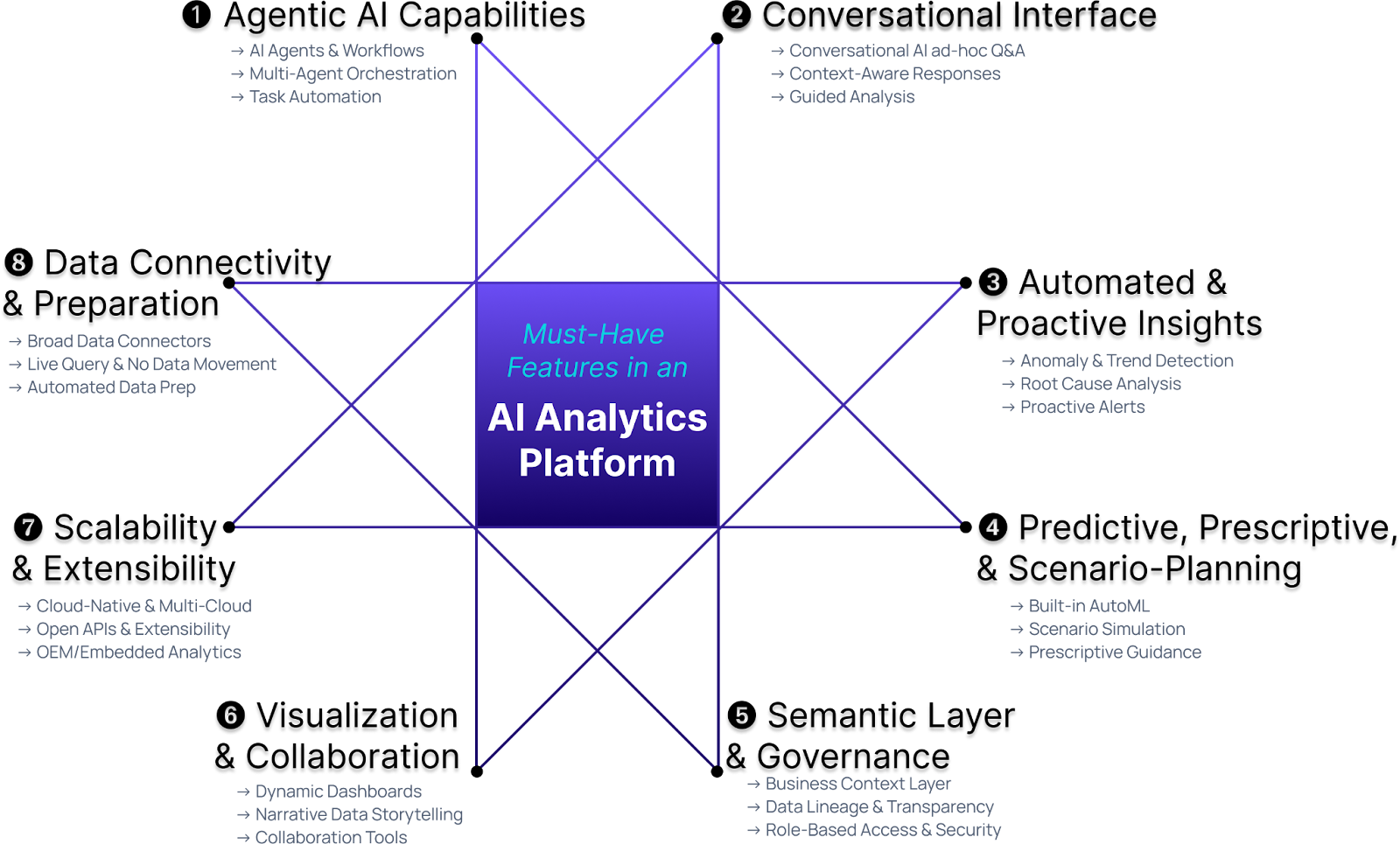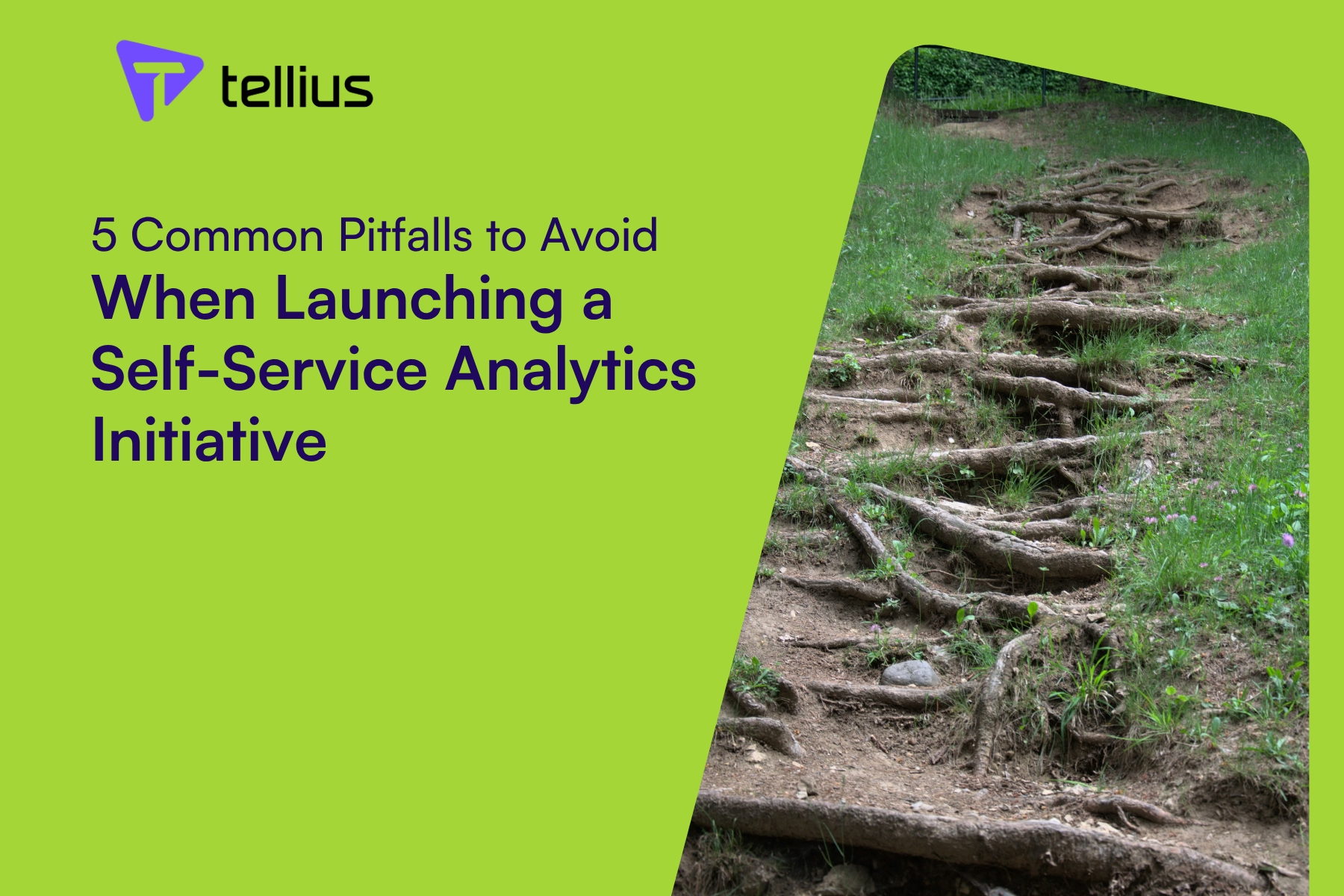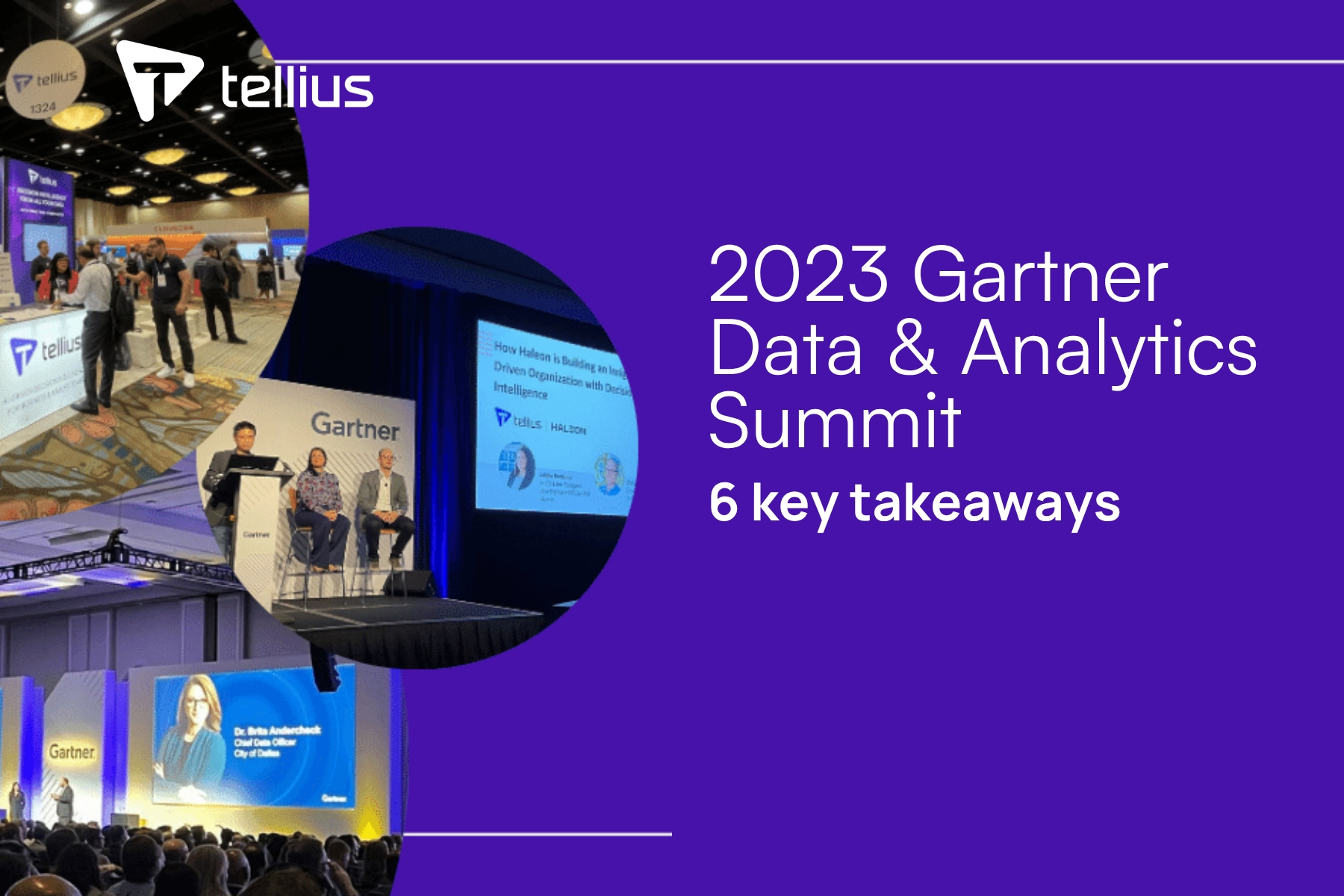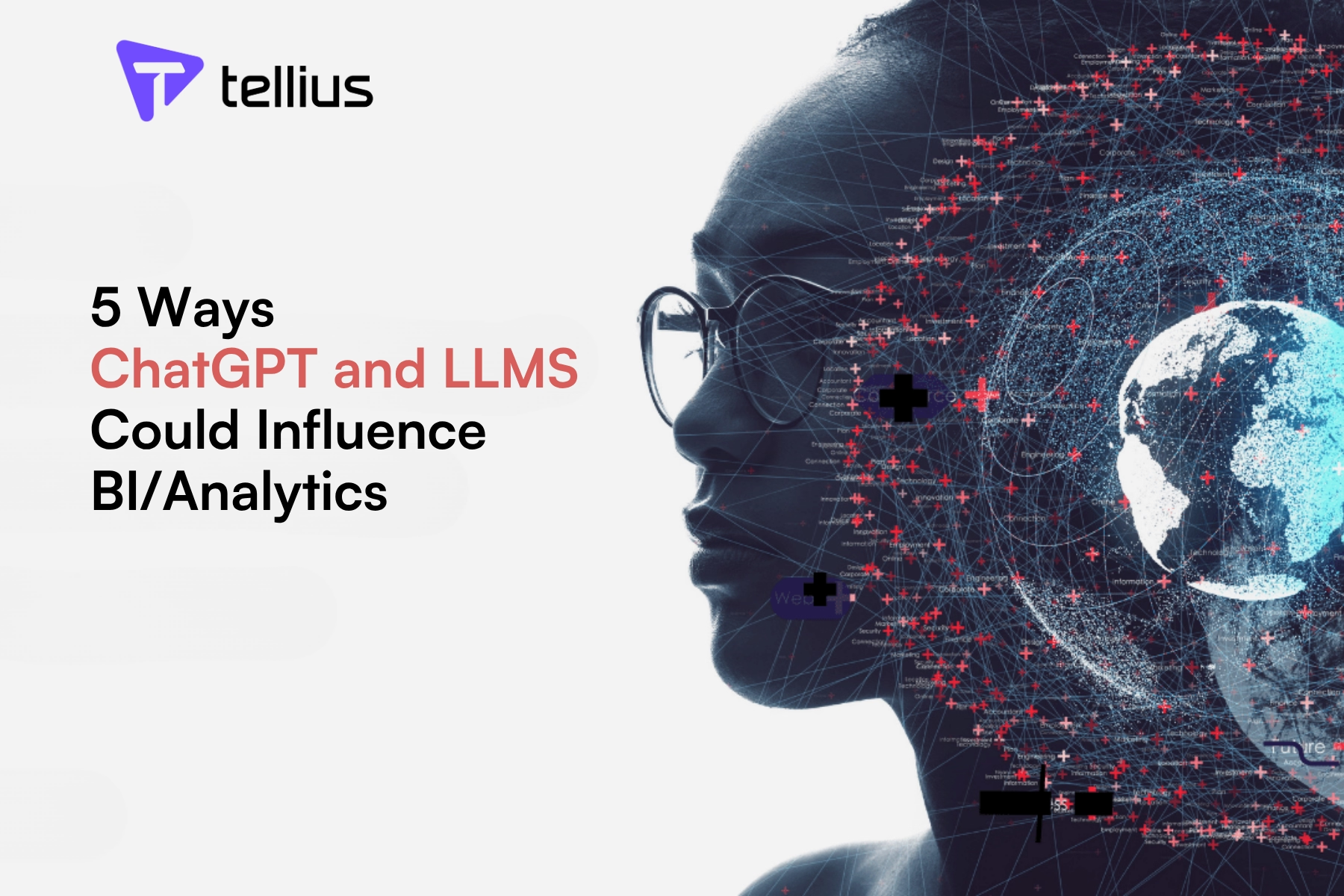AI Analytics & Agentic AI: Definition, Benefits, and Real-World Examples
.png)
AI analytics applies AI—ML, NLP, LLMs, and specialized AI agents—to analyze data, explain the drivers behind change, predict outcomes, and recommend next steps. Unlike legacy BI that stops at charts, AI-native platforms add multi-agent orchestration, a governed semantic layer, and deterministic analytics so insights connect directly to action.
TL;DR (executive summary)
- What: AI that answers why performance changed and what to do next—then executes approved actions.
- How: Multi-agent orchestration grounded by a semantic layer and governance (access control, approvals, audit trails, explainability).
- Value: Faster time-to-insight and time-to-action (seconds vs. days), higher decision confidence, lower manual handoffs.
What you’ll learn
- A plain-English definition of AI analytics (and what it is not).
- How analytics evolved from dashboards to agentic AI.
- The architecture that makes it enterprise-ready (application, reasoning, knowledge/semantic, trust).
- How AI agents and agentic flows detect, diagnose, recommend, and execute.
- Benefits that matter to leaders (speed, governance, decision velocity, cost).
- Examples from pharma, CPG, financial services, and retail—with outcomes.
- A pragmatic evaluation checklist and a five-phase rollout plan.
Most “AI analytics” posts rehash definitions or bolt a chatbot onto BI. This field guide blends real customer scenarios with the technical depth leaders need: multi-agent orchestration, a governed semantic layer, and a deterministic analytics engine for accurate numbers—plus the operational plumbing that turns insights into action.
What Is AI Analytics?
.png)
AI analytics applies machine learning, natural language processing, large language models, and specialized AI agents to analyze data, explain why performance shifts, forecast outcomes, and recommend next steps. Unlike legacy BI that stops at visualization, AI-native platforms add multi-agent orchestration, a governed semantic layer, and deterministic calculations so insights connect directly to action.
How AI Analytics Works in Practice:
- Interpret plain-language questions and map them to governed metrics and entities via the semantic layer.
- Explore structured and unstructured data to surface trends, anomalies, and true drivers—not just correlations.
- Run predictions and quick what-if simulations to estimate impact and risk.
- Orchestrate agentic flows that propose or trigger approved updates in CRM/ERP/marketing systems, with full auditability.
The result is a shift from periodic reporting to continuous, context-aware decisioning—with measurable improvements in time-to-insight and time-to-action.
What AI Analytics Is Not
To set a clear bar, AI analytics is not:
- An AI add-on for dashboards. Thin “insights” layers tend to miss business context and depth.
- Chat-only Q&A. Text-to-SQL without multi-step reasoning and action integration is faster querying, not analytics.
- Purely descriptive reporting. If it can’t explain why and suggest what next, it’s still BI.
- Ungoverned exploration. Enterprise use demands RBAC, approvals for high-impact actions, audit trails, and explainability.
Bottom line: without orchestration, a semantic layer, and governance, you have AI-powered BI, not an AI-native analytics platform.
Top Benefits of AI Analytics for Enterprises
- Speed to Insight with AI Analytics: Automated driver and anomaly analysis shrinks diagnosis from days to minutes.
- Faster time-to-action: Agentic flows route approved updates to CRM/ERP/MarTech—no swivel-chair handoffs.
- Decision confidence: Deterministic calculations + explainable outputs cut debate over “whose numbers are right.”
- Lower analytics toil: Fewer ad-hoc requests and throwaway dashboards; analysts focus on models and strategy.
- Governed consistency: A semantic layer enforces KPI definitions, hierarchies, and business rules across teams.
- Scales with your stack: Live/Pushdown to Snowflake/Databricks/BigQuery avoids data movement and surprises on cost.
- Enterprise-grade trust: RBAC, approvals, audit trails, lineage, and model/agent observability.
Measure it: Track time-to-insight and time-to-action pre/post; they’re the clearest proof points for executive buy-in.
From Augmented to Agentic AI: The Evolution of AI Analytics
Over the last decade, analytics moved from dashboards (descriptive) to augmented analytics assistive) and now to agentic AI (orchestrated, action-linked). The shift isn’t a feature—it’s how decisions get made: from asking and waiting to anticipating and acting.
AI Analytics vs Traditional BI: Evolution at a Glance
Here’s how AI-native analytics differs from traditional and ‘AI-powered’ BI across capabilities, data scope, and governance.
Why this matters: Agentic AI closes the gap between detection and execution. That speed shows up as revenue protection, lower costs, and better customer outcomes.
Expert Insight:
“We’re moving from a generative‑AI world into an agentic world. Agentic AI is more about a goal‑driven approach, where the AI is capable of making decisions and taking actions on behalf of the human.”— McKinsey, The future of customer experience: Embracing agentic AI, June 11, 2025
AI Analytics in Action: Micro-Scenarios
- Pharma: Formulary shift detected → territory impact scored → approved rep lists + messaging pushed to CRM.
- CPG: Demand dip predicted → pricing + supply agents coordinate targeted promo and inventory move pre-markdown.
- Financial Services: Fraud cluster crosses threshold → compliance workflow freezes accounts with explainable evidence.
Key takeaway: Augmented analytics reduces time to answer. Agentic analytics reduces time to action.
How an Enterprise-Grade AI Analytics Platform Works
Not all AI analytics platforms are equal. Many “AI-powered” add a chatbot to legacy BI. An AI-native, agentic platform connects understanding → reasoning → action in one loop with governance.

The 4-Layer AI Analytics Platform Architecture Explained
1) Application / UI Layer — where people ask, review, and approve
What it is: The interaction surface for business users and analysts.
Key capabilities:
- Conversational analysis: plain-language questions mapped to governed metrics and entities.
- Insights feed: pushes anomalies, drivers, and trends proactively (not just on request).
- Agent console: view running agentic flows, approve actions, and monitor results.
- Analyst workspace: drill, slice, and save narratives/visuals for sharing and reuse.
Why it matters: Keeps humans in the loop; answers are explainable, actions are reviewable.
2) Intelligence / Reasoning Layer — the orchestration brain
What it is: Planning, decomposition, analysis, and multi-agent coordination.
Key capabilities:
- Intent parsing & planning: classifies the request (exploratory/diagnostic/predictive/prescriptive) and breaks it into steps.
- Smart Query / Planner: selects datasets, features, and methods (e.g., trend → driver → impact → what-if → recommendation).
- Deterministic analytics engine: computes all numbers precisely; LLMs handle language understanding and narrative—not math.
- Multi-agent orchestration: runs specialized agents in sequence/parallel, passes context/memory between them.
- Pushdown / Live Mode: executes queries in your cloud warehouse (zero-data-movement) for speed, scale, and cost control.
- Guardrails: policy checks, tool-use limits, and agentic RAG against approved knowledge.
Why it matters: Produces accurate, reproducible results and turns reasoning into coordinated action—not just a one-off answer.
3) Knowledge / Semantic Layer — the business brain
What it is: The context that makes answers consistent across teams and tools.
Key capabilities:
- Data modeling & joins: unify warehouse, CRM, ERP, marketing, and external sources.
- Semantic layer: defines KPIs, hierarchies, time grains, synonyms, and entity relationships (e.g., “Gross margin excludes freight”).
- Business logic & policies: embed rules, thresholds, and eligibility criteria agents must respect.
- Unstructured + structured fusion: ingest documents/logs, index with vectors, and ground agent answers via governed retrieval.
Why it matters: Agents interpret questions the same way people do; definitions don’t drift, and insights remain trustworthy. See AI Agents at Work.
4) Trust & Governance Layer — security, controls, and explainability
What it is: The enterprise guardrails across the entire loop.
Key capabilities:
- RBAC & data permissions (row/column level), secrets management, and tenancy isolation.
- Approvals for high-impact actions with maker–checker separation.
- Audit trails & lineage: inputs, steps, outputs, and who approved what—end to end.
- Explainability: show features, drivers, and rationale behind recommendations; link to source evidence.
- Observability: health, drift, and performance monitoring for agents and pipelines.
Why it matters: Builds trust with security teams and keeps AI decisions reviewable and compliant.
End-to-End Flow of AI Analytics: Detect → Decide → Act
- Detect a signal (e.g., formulary change or demand dip) in the insights feed.
- Diagnose with driver/anomaly analysis across domains via orchestrated agents.
- Simulate with quick what-if to size impact and risk.
- Recommend next-best actions with confidence and prerequisites.
- Execute (with approval) via connected systems (CRM/ERP/MarTech); log everything for audit.
Tellius / Kaiya differentiators: multi-agent orchestration with shared context, a deterministic engine for numbers, Live Mode pushdown to Snowflake/Databricks/BigQuery, and a governed semantic layer for consistent answers.
AI Agents & Agentic Flows: How Work Gets Done in AI Analytics
With the architecture in place, the real engine is the combination of specialized AI agents and agentic flows. Agents handle domain-specific tasks; flows coordinate them to detect change, diagnose root causes, simulate options, and route approved actions to the systems that run your business.
Exec Takeaways:
- Agents = specialized, context-aware analysts grounded by the semantic layer.
- Flows = orchestrated, multi-step workflows that close the loop from detect → decide → act.
- Result = measurable drops in time-to-insight and time-to-action.
What Are AI Agents in Analytics?
An AI agent is an autonomous, context-aware component that monitors data, applies business rules, and collaborates with peer agents to complete a task.
- Specialized: built for domains/tasks (e.g., Payer Performance, Demand Forecast, Fraud).
- Context-aware: uses governed KPIs, hierarchies, and policies from the semantic layer.
- Persistent: learns from prior runs; keeps memory where appropriate.
- Connected: passes outputs to other agents during a flow.
Why it matters: Agents bring depth and consistency; they interpret questions the way your business defines them—not the way columns are named.
What Are Agentic Flows in AI Analytics?
An agentic flow is a coordinated sequence of steps carried out by one or more agents that connects analysis directly to a recommended—and optionally executed—action.
How a flow runs:
- Trigger — a signal fires (e.g., sales dip, formulary change, fraud cluster).
- Detection — an agent validates the event in real time.
- Diagnosis — peer agents run driver/anomaly/root-cause analysis across data domains.
- Simulation — quick what-if to size impact and risk.
- Recommendation — next-best action, confidence, and prerequisites.
- Execution — approved actions pushed to CRM/ERP/MarTech; everything logged for audit.
One concrete example:
- Pharma: Formulary shift detected → territory impact scored → Kaiya drafts targeted rep lists + messaging in CRM → manager approves → assignments routed automatically.
Kaiya: Orchestrating Agentic Flows (How Tellius Runs It)
In Tellius, Kaiya is the coordinator that turns the framework above into daily operations. It:
- Breaks a business objective into ordered tasks.
- Assigns tasks to the right specialized agents and passes context between them.
- Uses the semantic layer to keep definitions consistent and the deterministic engine for numbers.
- Surfaces results for review and, when approved, pushes actions to CRM/ERP/MarTech—fully audited.
“Agentic flows are the connective tissue of AI analytics…with Kaiya, insights don’t stall—they reach decision-makers when it matters most.” — Vinod Iyengar, Head of Product, Tellius
Before vs After:
Why It Matters: Agentic flows turn AI analytics from an insight factory into an action engine. By collapsing the lag between detection and execution, they make organizations faster, more responsive, and better able to capitalize on opportunities or mitigate risks.
Conversational AI as a Capability Within AI Analytics

Conversational AI lets people ask plain-English questions and explore quickly. In a modern AI analytics stack, it lives in the Application/UI layer and works hand-in-hand with agents and agentic flows—it starts the work; orchestration finishes it.
Where Conversational AI Shines
- Low-friction entry point for business users (no SQL).
- Maps questions to governed metrics via the semantic layer.
- Great for follow-ups: drill, compare peers, explain a chart with narrative.
Limitations of Standalone Conversational AI
- Reactive loop: answers only what you ask; unseen issues remain hidden.
- No orchestration: doesn’t plan multi-step analysis or route actions.
- Context drift without governance: without a semantic layer + approvals, trust erodes.
Bottom line: Conversational AI is the doorway. Agentic analytics—multi-agent reasoning + governance—gets you to decisions and actions.
How Agentic Analytics Extends Conversational AI
- Ask: “Why did West region drop last week?”
- Plan & Diagnose: agents decompose the task (trend → drivers → peer benchmarks → what-if).
- Recommend: next-best actions with confidence and prerequisites.
- Approve & Execute: updates push to CRM/ERP/MarTech; everything is logged.
- Learn: outcomes feed back to agents for the next run.
Quick example (retail): A manager asks about a margin dip. The system explains the drivers, simulates a price test, proposes SKUs to adjust, and—after approval—publishes updated prices to e-commerce and POS, with an audit trail.
Real-World Case Studies: How AI Analytics Delivers Results
Nearly all industries are using AI analytics platforms to detect changes faster, uncover patterns or root causes, and act with precision. These examples highlight how AI analytics — powered by orchestrated, multi-step capabilities — delivers tangible business wins.
Pharma — Launch & Market Access
- Trigger: Formulary status change detected.
- Flow: Payer Performance → Sales Impact → CRM outreach (manager approval).
- Action: Targeted rep lists + messaging pushed to territories.
- Result: 3 weeks → 3 days time-to-intervention; +5% market share in priority areas.
Consumer Goods — Markdown Reduction
- Trigger: Predicted demand dip for seasonal lines.
- Flow: Demand Forecast → Pricing → Supply reallocation.
- Action: Promo optimization and inventory move before markdowns.
- Result: 18% markdown reduction; $2.4M saved; forecasting now always-on.
Financial Services — Fraud Containment
- Trigger: Small-dollar anomaly cluster crosses threshold.
- Flow: Detection → Compliance workflow (freeze + explainable evidence).
- Action: Temporary holds + incident log; rapid analyst review.
- Result: $750K prevented in 48 hours; −22% false positives.
Retail — Pricing Agility
- Trigger: Margin erosion + competitor price change.
- Flow: Driver analysis → price test simulation → approved push.
- Action: Updates published to e-commerce & POS with audit trail.
- Result: +12% promotion ROI; lower markdown costs; faster flash promos.
Across every example, the loop is the same: detect → diagnose → simulate → execute. Teams win when that loop gets faster—measured by a shorter time-to-action. See It in Action on Your Data.
How to Choose the Best AI Analytics Platform

The AI-analytics market is packed, and plenty of tools slap “AI-powered” on a text-to-SQL bot or an auto-insight button. That’s not AI-native analytics.
If you’re choosing a platform, you’ll be tasked with sorting through who’s truly innovative and who’s AI-washing. To get started, check out the below AI analytics platform evaluation checklist to help guide your selection.
Executive summary
- Prioritize AI-native, agentic orchestration grounded by a semantic layer and real governance.
- Require deterministic math (LLMs for language only), pushdown/live query, and audited execution to CRM/ERP/MarTech.
- Validate via a measurable pilot focused on time-to-action, not just time-to-insight.
Best-in-Class AI Analytics versus Table Stakes:
1. AI-Native Architecture
Short list the platforms built from the ground up to integrate AI into every layer of analytics. What to look for:
- Planner – Decomposes complex goals or objectives into clear steps.
- Intent Parser – Classifies and routes requests appropriately.
- Semantic Layer – Grounds the outputs in your unique business definitions and enterprise knowledge.
A retrofitted BI tool will always struggle to deliver consistent and explainable results without these core components.
2. Multi-Agent Orchestration
A single “generalist” AI agent isn’t enough. You need:
- Specialized agents for different domains or tasks.
- The ability for agents to collaborate and pass outputs between them.
- Orchestration that runs agents in sequence or parallel, depending on the task at hand
Without this, complex, cross-domain analysis won’t scale and actions will fall flat.
3. Governance, Trust, and Explainability
Enterprise-grade governance isn’t optional (we think your CISO will agree):
- Role-based access controls are a must
- Approval workflows for high-impact actions.
- Detailed audit trails that leave no detail in the dark
- Robust explainability features showing how conclusions were reached.
These are crucial to both trust and compliance.
4. LLM-Agnostic Flexibility
You’ll always want to avoid platforms tied to a single large language model. Choose LLM-agnostic solutions that can switch or even blend models as better options emerge.
5. Agent Authoring & Debugging Tools
Your business is unique, and your AI should reflect that. Look for:
- Low/no-code tools to create custom agents and build on out-of-the-box offerings
- Sandboxed environments for testing.
- Debugging tools to improve agent performance.
Key Questions to Ask Vendors (For Your RFP)
- Orchestration: How do agents share context? Can flows run in parallel? Show the plan view.
- Determinism boundary: What computes the numbers? Where do LLMs stop?
- Semantic layer: How are KPIs versioned/enforced across tools? Support synonyms/time grains?
- Pushdown: Demonstrate a live warehouse query at scale; show cost controls/quotas.
- Governance: Where are approvals configured? Show the audit trail on a completed action.
- Explainability: For a recommendation, show drivers, evidence, and uncertainty.
- Write-backs: Which systems can you update directly? What’s the rollback path?
- Observability: How do we monitor agent quality, drift, failures? Expose metrics/logs?
- Security: SSO/SAML, SCIM, key mgmt, data residency, VPC/VNET options.
- Roadmap cadence: GA vs beta; SLAs for fixes and shipping frequency.
Proof to Demand in an AI Analytics Demo or Pilot
- One real flow end-to-end: detect → diagnose → simulate → recommend → approve → push.
- Time studies: Baseline vs post-pilot time-to-insight and time-to-action.
- Cost profile: Warehouse credits with pushdown vs import; expected seat/usage model.
- Governance in action: Maker–checker approval, audit log export, permission test.
- Data mess tolerance: Include structured + unstructured sources.
- Accuracy check: Deterministic result verified in SQL; narrative matches numbers.
Getting Started with AI Analytics
AI analytics rewires how decisions happen–and a simple, staged roadmap keeps you out of the pilot trap and focuses momentum on the measurable business outcomes.

Phase 1: Pick the Use Case (Weeks 1-2)
Owner: Business lead (+ analytics lead)
Inputs: KPI baseline, systems in scope, data owners
Deliverable: 1-page use-case brief (problem, KPI, trigger signal, target action, guardrails)
Criteria: measurable KPI, available data, clear “system of action”
Risks: boiling the ocean → Choose 1 flow only.
Phase 2: Connect & Contextualize Data (Weeks 2-4)
Owner: Data eng + analytics lead
Deliverables: data model, semantic layer (KPI defs, entities, hierarchies), access controls
Checks: freshness SLAs, data permissions, PII policy
Pitfall: skipping semantic definitions → enforce KPI versions & synonyms.
Phase 3: Deploy 2-3 Core Agents + First Flow (Weeks 4-6)
Owner: Analytics lead
Agents (examples): Payer Performance / Demand Forecast / Fraud Detection
Flow: trigger → detect → diagnose → simulate → recommend → approve → push
Deliverables: flow plan, approval path, rollback plan
Guardrails: deterministic engine for numbers; LLMs for language/narrative only.
Link them into an agentic flow that connects detection → diagnosis → recommended action.
Phase 4: Train, Monitor, Iterate (Weeks 6-8)
Owner: Change mgmt + analytics team
Deliverables: 60-min training, runbook, dashboard for pilot KPIs
Monitor: precision/recall (detections), explanation quality, action approval rate
Action: tune prompts/policies, fix false positives, tighten approvals.
Phase 5: Scale (Months 3-6)
Owner: Analytics COE + IT/security
Deliverables: additional flows, governance playbook (RBAC, approvals, audit exports), integration to CRM/ERP/MarTech at scale
Exit criteria: pilot KPIs met; security review signed off.
Pro Tip:
Track time-to-insight and time-to-action before AND after implementation. These metrics will be your strongest proof points for executive buy-in and budget expansion.
The Future of AI Analytics and Agentic Workflows
AI analytics is no longer about prettier charts—it’s about compressing the gap between signal and approved action. The leaders are AI-native and agentic: they reason across steps, stay grounded in business definitions, and execute with governance.
In one glance
- AI-native stack: application/UI, intelligence & orchestration, knowledge/semantic layer, and trust & governance.
- Operating model: specialized agents coordinated in agentic flows to detect → diagnose → simulate → execute.
- Business outcome: measurable drops in time-to-insight and, more importantly, time-to-action.
- Start focused. One high-impact use case, measure time-to-insight and time-to-action, then scale.
With Kaiya, Tellius turns this into daily practice. Kaiya orchestrates specialized agents, uses a deterministic engine for numbers, and routes approved updates to the systems you already run—so teams get context-rich guidance they can act on immediately.
Ready to see AI Analytics in Action?
Tellius bridges the gap between curiosity and confident action. The platform connects to all your data, understands your business language through its semantic layer, and reasons across steps with specialized AI agents. Every insight is explainable, every action auditable, and every decision faster—so your teams can move from exploring data to executing outcomes with clarity and control.
Book a demo to see how Tellius AI Analytics and Kaiya can help you turn insight into impact — faster.
Get release updates delivered straight to your inbox.
No spam—we hate it as much as you do!

AI Analytics is the use of artificial intelligence to automate and enhance data analysis, moving beyond traditional dashboards. Instead of only showing what happened, AI analytics uses machine learning, natural language processing, and agentic AI to explain why changes occur, recommend next steps, and even trigger actions. It works by layering AI models and semantic context over enterprise data, allowing users to ask questions in plain language, uncover root causes instantly, and orchestrate workflows across systems.
Enterprises apply AI analytics across industries to speed decision-making and improve outcomes. In pharma, companies use AI analytics for launch performance optimization, cutting intervention times from weeks to days. In CPG demand forecasting, AI analytics helps optimize inventory and reduce markdowns. In financial services, AI analytics enables fraud detection and prevention, stopping fraudulent transactions in real time while reducing false positives. In retail, dynamic pricing optimization improves ROI on promotions and minimizes margin erosion.
Traditional BI tools focused on dashboards and descriptive reporting—answering “what happened” after the fact. Augmented analytics introduced automation, natural language queries, and AutoML to accelerate insights and explain “what” and “why.” AI analytics goes a step further. It enables agentic intelligence, where multiple AI agents collaborate to detect change, uncover root causes, recommend next steps, and orchestrate actions. Unlike BI, which is reactive, or augmented analytics, which is still mostly assistive, AI analytics is proactive, contextual, and outcome-driven.
An enterprise-grade AI analytics platform should combine both intelligence and governance. Must-have features include: agentic AI capabilities such as multi-agent workflows and orchestration; conversational interfaces for natural Q&A; automated and proactive insights like anomaly detection and root cause analysis; predictive and prescriptive analytics with AutoML and scenario simulation; a semantic layer for context and governance; visualization and collaboration tools; scalability with multi-cloud and API extensibility; and robust data connectivity and preparation.
Organizations adopting AI analytics see measurable business impact. In pharma launches, it accelerates market share recovery. In CPG and retail, it improves forecasting and dynamic pricing, reducing markdowns and boosting profitability. In financial services, it prevents fraud in real time, saving millions and reducing false positives. Across industries, AI analytics outcomes include faster decision cycles, improved accuracy, cost savings, higher ROI, and more agile operations—shifting from static dashboards to intelligent systems that drive real-world results.
Enterprises should prioritize AI-native analytics platforms—not legacy BI tools with AI add-ons. Leading solutions like Tellius combine a governed semantic layer, deterministic analytics, and multi-agent orchestration to connect insight directly to action. These platforms deliver faster time-to-insight, enterprise-grade governance, and explainable, goal-driven intelligence that scales across data sources and business functions.
Large Language Models (LLMs) and natural language interfaces make analytics conversational—users can ask questions in plain English instead of writing SQL or building dashboards. In AI analytics platforms like Tellius, LLMs interpret intent, map queries to governed metrics, and generate clear, contextual explanations. This makes exploring data faster, more intuitive, and accessible to every decision-maker, regardless of technical skill.
The biggest challenge is mistaking AI-powered BI for true AI analytics. Many teams struggle with data silos, inconsistent KPI definitions, and lack of governance when scaling new AI tools. Successful transitions focus on establishing a semantic layer, enforcing role-based access, and adopting platforms like Tellius that pair multi-agent reasoning with explainable, governed workflows to ensure trust and accountability.

5 Common Pitfalls to Avoid When Launching a Self-Service Analytics Program

Here are some common pitfalls we've seen for organizations launching a self-serve analytics vision—and how to avoid them to maximize your odds of success.

6 Key Takeaways from the 2023 Gartner Data & Analytics Summit

This year’s Gartner Data & Analytics Summit in Orlando was a jam-packed three days of 220+ sessions, keynotes, and networking opportunities attended by over 4,000 data and analytics leaders and industry experts.

5 Ways ChatGPT and LLMs Could Influence BI/Analytics

Learn how ChatGPT and the foundational technology it is built upon will have a transformative impact on data & analytics.

